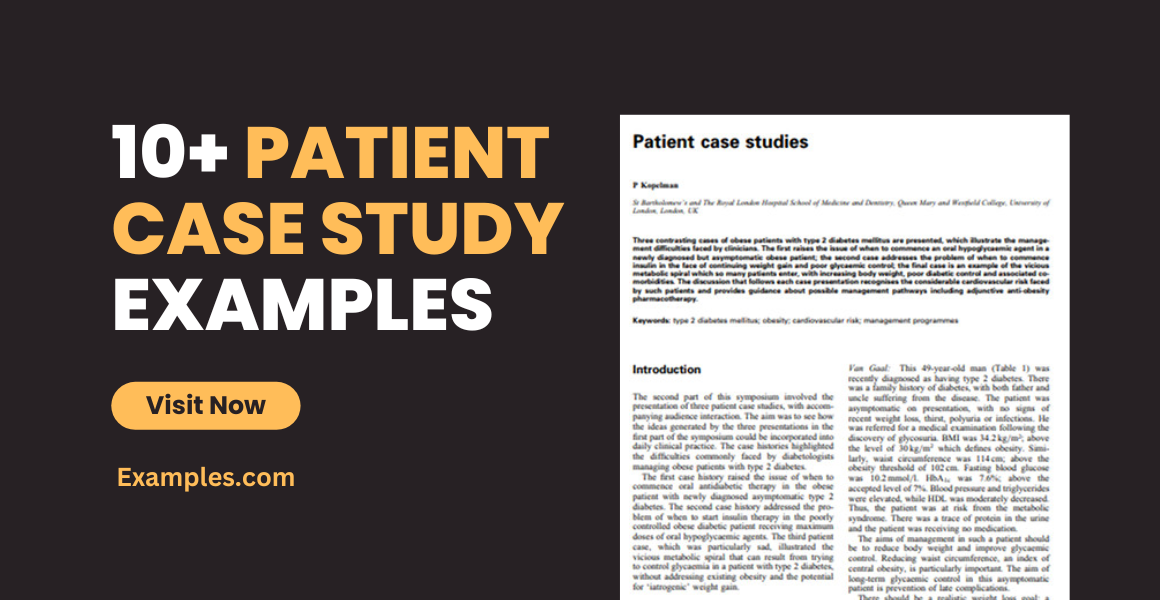10+ Patient Case Study Examples to Download
Case studies are a qualitative research method that offers a complete and in-depth look into some of the situations that baffled medical science. They document the cases that escape the ordinary in a hospital that has seen a manifold of plights. They serve as cautionary tales of the intricacy in dealing with human health.
It is a well-established empirical research approach that illuminates a stand-out case of a subject or a group of subjects. In the end, it seeks to introduce new information for the understanding of the nature of a disease or medical condition in the context of someone who has lived it. Patient case studies make a difference in the medical arena by reporting clinical interactions that can improve medical practices, suggest new health projects, as well as provide a new research direction. By looking at an event as it exists in the natural setting, case studies shed understanding on a complex medical phenomenon.
Case Study Pitfalls
Writing case studies can be no different than writing a research paper, with a few tweaks in the paper’s template and format. However, there are different blunders to avoid in preparing your report.
Since it documents stand-out clinical interactions where a single person or a few number of people are a party of, the findings may not be valid for generalization for a wider population. Therefore, you should avoid making motherhood statements and misleading conclusions just to make your study seem relevant where it isn’t. Your findings should stick to the evidence and data that you possess.
Because you are studying a case valid only for some people as of the moment, you should indicate the general scope and limitation of your work. The scenario might be different when placed in a different context. You should be honest in reporting the information about your study. Disclose the limits of your findings.
You are working on limited information. You should look into all of the possible explanations for the medical condition at hand. If a plight can be explained by more than one reason, then you have to look into the less obvious but similarly compelling explanations. Make your case study as informative as possible.
Case For Generalization
You cannot generalize a population using one case study. However, multiple case study contains two or more cases under the point of interest can give you a replicated result. When the findings remain true for several cases under this research method, your case study’s results become more reliable.
10+ Patient Case Study Examples
Medical practitioners use case studies to examine a medical condition in the context of a research question. They perform research and analyses that adhere to the scientific method of investigation and abide by ethical research protocols. The following are case study samples and guides on case presentation.
1. Patient Information for Single Case Studies Example
2. Sample Case Study Base on Acttual Patient Example
3. Ethical Legal Analysis of Patient Case Study Example
4. Patient Audit Case Study Example
5. Brain Injury Patient Case Study Example
6. Simple Patient Case Studies Example
7. Cellulitis Patient Case Study Example
8. Not-for-Profit Hospital Patient Case Study Example
9. Case Study of a Narcoleptic Patient Example
10. Drugs Patient Case Study Example
11. Patient Case Study in DOC
Writing Your Patient Case Study
Since patient case studies are generally descriptive, they are under the a phenomenological principle. This means that subjectivity is entertained and allowed in research design. The medical scenarios are open to the researcher’s interpretation and input of insights. The following are reminders on how to prepare your case study analysis.
1. Work on Your Introduction
Select a case. You have to identify your focus and scope for the study. Like other research papers, you should prepare a research outline that guide you during the whole study duration. Another thing to produce is a related literature review. You should know about what you are going to study, and if any other investigation has been done on the material. When you have properly organized your information, you will have a smooth flow of ideas.
2. Get to Know the Participants
You can have one or multiple case participants. While other research methods boast of data credibility and generalizability, the small number of subjects in a case study is working for its advantage. The researcher is more attentive about his or her participants, and in-depth treatment of the study will not be very difficult. What case studies lack in generalized conclusions, they make up for thorough analysis of a subject matter.
3. Perform Data Analyses Method
Your results will depend on your interpretation of the raw data. Some researchers interpret their study data as the big picture while others dive into each pixel of the image. Be sure to extrapolate on all the possibilities that could help make sense of your case. You can compare your findings with present literature. Leave no stone unturned as you get down to the bottom of the investigation. Your data is only as good as your explanation.
4. Report the Case Study Results
Your patient case analysis is an investigation of a medical plight or case. When you present your findings, you have to balance the description of the situation and the detailing of the analyses. You have to illustrate how and why you came to a conclusion by providing the necessary background information. In the end, you can suggest future research or improvement built on what you have accomplished in this case study.
Against evidence-and-experiment-based research methods, case studies seem to have the lower end of the stick on the issue of reliability. However, case studies offer a comprehensive and exhaustive treatment on a complicated subject matter in a real-life setting. This research method lets you gain an appreciation for a concept beyond what cold, hard facts can provide. There is no single approach to science and knowledge.













